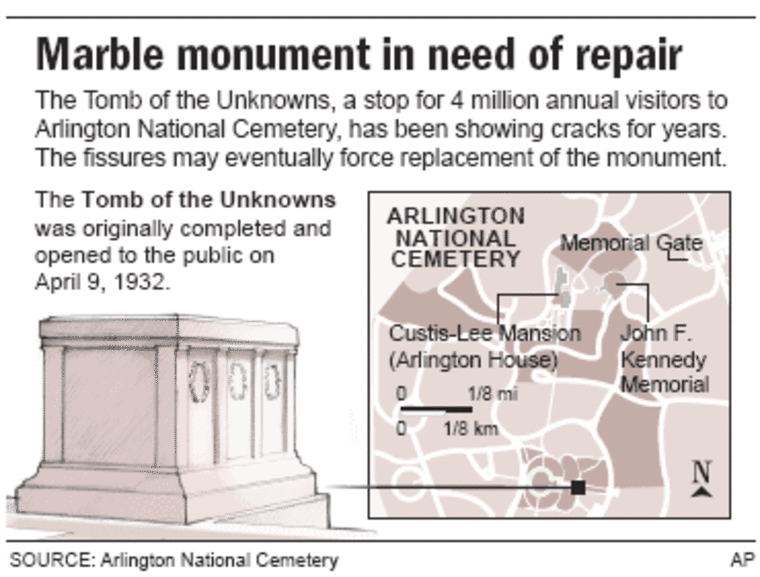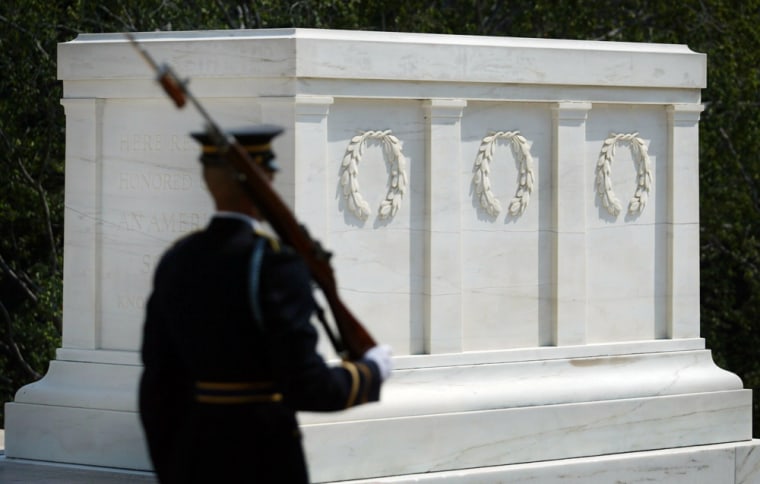Most visitors are probably too busy watching the poised and polished guards make their endless march in front of the Tomb of the Unknowns to see the cracks that wrap their way across the white marble monument like string around a package.
Each year, those cracks creep farther and deeper.
The 74-year-old monument, the scene of Memorial Day wreath-layings by the president and a must-see stop for the 4 million annual visitors to Arlington National Cemetery, is not in danger of crumbling any time soon. But the cemetery is deciding whether to patch the fissures or replace the marble altogether.
“We know this is not a stagnant thing,” said John Metzler, the cemetery’s superintendent. “This thing is continuing to move.”
Cemetery officials are taking public comments through Aug. 6 and plan to choose an option by September. The cemetery could repair it, do nothing or buy an extra marble block and store it as a standby if the tomb continues to deteriorate.
A 1990 report concluded that within 10 to 20 years, the damage could lead to a “negative effect on visitors' experiences.” Metzler said he feared some of the carved sculptures could eventually fall off.
Replacement may take a year
Replacing the monument now would take about a year and could cost up to $1 million. The tomb would be closed to the public for about two weeks, Metzler said. Filling the cracks would be cheaper and quicker but might not solve the problem.
The sculpted sarcophagus has a commanding view of Washington across the Potomac River. With shouldered rifles, soldiers from the Army’s 3rd Infantry “Old Guard” Regiment guard it at all times, making a 21-step march in front of the tomb, clicking their heels at each turn.
Beneath the marble structure is a crypt holding the remains of three unidentified servicemen killed in the two world wars and the Korean War. A Vietnam War soldier buried there was later identified through DNA testing and removed. An inscription on the tomb reads: “Here Rests in Honored Glory an American Soldier Known But to God.”

First seen in the 1940s
Cracks were first noticed in the 1940s, but Metzler said flaws were probably present when the tomb was installed in 1932. By the late 1980s, when a study of the damage was done, the largest had stretched 28 feet.
The marble block was probably cut from a Colorado quarry using dynamite, creating unseen cracks that were later worsened by exposure to rain and freezing cold, Metzler said.
The most noticeable crack cuts right through the middle, prominent enough that it even appears on a scale model of the tomb in the cemetery visitors’ center. It cuts in half the sculpted figures of Greeks representing Peace, Victory and Valor on one side, and runs right below the words “An American,” as if underlining it for emphasis.
The tomb has been patched repeatedly, most recently in 1989. But the 1990 report concluded the fissures would only get worse. That year, Rex Loesby, then-owner of the Colorado quarry that supplied the rock, said he could provide another stone. After several stalled attempts, the cemetery started the replacement process again this year.
What took so long?
Some wonder why it took so long. John Haines of Glenwood Springs, Colo., offered to pay $31,000 for the marble block about five years ago and donate it. Haines has never visited the tomb, but said he was moved to act by the “freedoms I’ve got because of what those guys gave.” The block has been cut from the quarry and sits on a trailer, awaiting shipment.
“It is ready to go whenever they get ready for it,” Haines said. “How much sense does it make to fix what’s already there, especially when you’ve got a fool who is ready to give you a piece?”
Metzler said the process is taking longer because the cemetery intends to get reaction from the public and historic preservation groups first. Any replacement contract would also probably go up for competitive bidding, he said.
A new tomb would be an exact replica of original, with a computer using digital photos to carve the details. The old tomb would probably go into storage, Metzler said.
Of the roughly 160 public comments submitted through last week, about 60 percent favor replacing the monument, according to cemetery officials. But not all want to replace a monument that has stood for generations and carries such symbolic weight.
“Leave it alone, it’s not going to fall apart,” said Steve Jeffrey, a 34-year-old from Pleasanton, Calif., who had just seen the tomb on a hot July evening. “I like the fact that it is original.”
